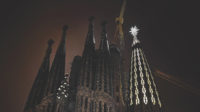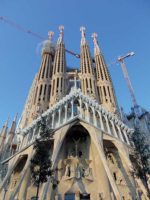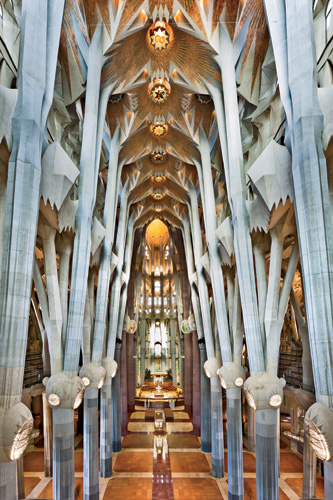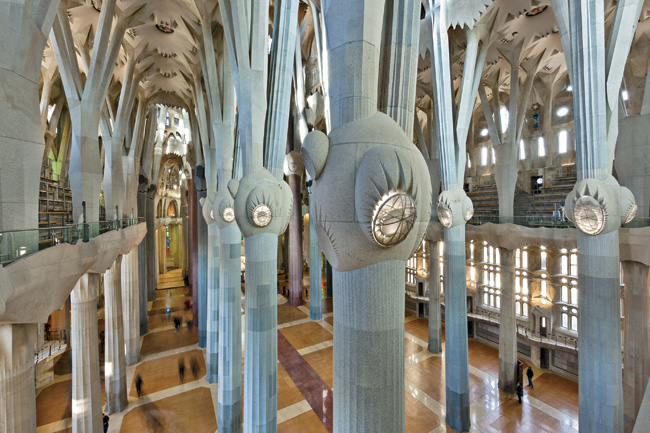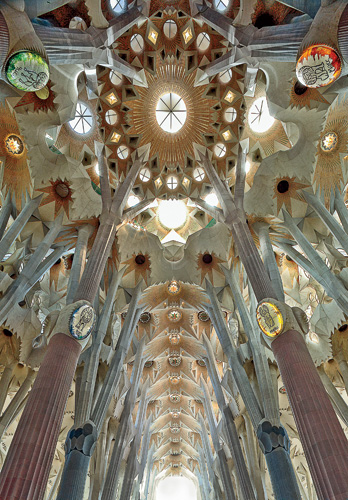La Sagrada Familia by Jordi Faulî and Anoche
Barcelona




























Architects & Firms
Lighting an iconic building designed more than a century ago is a challenge—especially when the project was never completed. Yet the inventive solutions for the nave of Antoni Gaudí's La Sagrada Família Basilica in Barcelona—still under construction 88 years after the architect's death in 1926—offer a close-up view of how contemporary designers are bringing this eccentric masterpiece to fruition. Their efforts are a labor of imaginative extrapolation, as anarchist militiamen destroyed all of Gaudí's original plans and models during the Spanish Civil War in 1936, when little more than the four towers of the Nativity Portal were complete. Using pieces of smashed plaster models, surviving molds, photos, written testimonies, and other documents, successive teams of architects have worked since 1940 to push the project forward. In this process, they have filled in unspecified details as best they could, working with artists and craftsmen, with controversial results but great popular success.
Additional Content:
Jump to credits & specifications
When it came time to consider lighting the nave, the design team—including Barcelona-based lighting specialists Anoche Iluminación Arquitectónica, led by Marià Vallès (with earlier contributions by architect Xavier Ferrés and the firm Biosca & Botey)—found both basic concepts and a surprising number of details in Gaudí's words and recovered documentation. These contained photos of plans and models, which they studied and meditated upon as if they were themselves sacred texts. Citing the written testimony of his disciples, collected after the master's death, Faulí explains, “The light in the temple should be harmonious but limited, neither too much nor too little, Gaudí said. And with a clear intent, to create an atmosphere conducive to meditation and the celebration of the Mass.” Amid the branching columns and hyperbolic vaults of the nave, Gaudí foresaw a regular distribution of luminous symbols, starlike point lights and nearly 300 skylights illuminated by both daylight and electricity, “like the light that enters a forest canopy,” Faulí comments. “He wanted the light to increase towards the altar,” and so the original design provided two larger skylights over the apse and crossing, dedicated to God the Father and the Holy Spirit.
The level of detail that the design team has found for these lighting elements amid the fragments of Gaudí's studio is astounding, though they haven't hesitated to use the most advanced technical means to realize them. For the 300 smaller skylights of the vaults, Faulí quotes Gaudí directly, as recorded by a disciple: “The skylights of the central nave are equipped with large lanterns, made with metal fabric with diverse meshes to produce a glimmering light.” A tiny original plaster cast of one, embossed with a miniature religious symbol, survives from a destroyed model.
With this as a reference, the Anoche team developed a fixture with a lightweight aluminum frame. Finished in stainless-steel mesh, this large luminaire adapts to the hyperbolic form of the skylight opening, and houses a ring of LEDs inside its perimeter. They suspended the fixture just below the opening, to emit light laterally across the vaulted ceiling. Craftsman Josep San Juan made the diffusers in fused colored glass, with Gaudí's symbols as interpreted by artist Antoni Vila.
Anoche also designed a variation on this LED fixture for the illuminated medallions that decorate the ellipsoidal “knots” or capitals of the piers, which connect the main shafts to their branching arms. Here crisscrossing loops of flexible steel rods and wire secure the glass diffusers in place against the stainless-steel mesh behind them. (A work in progress, only a handful of the fused-glass medallions have been finished; the remaining fixtures have temporary glass lenses).
The designers chose LEDs as the light source in these particular fixtures to achieve an even and indirect illumination. Additionally, they plan to replace existing halogen downlights—temporarily installed for the papal visit in the starlike point lights of the vaults—with LEDs, which offer a smaller point of emission and a softer, subtler light. These point lights are to be installed in recesses that Gaudí designed in the ribs of the vaults. Vallès marvels at Gaudí's apparent foresight, remarking, “Nothing in his time could have effectively thrown light 130 feet,” the distance from the vaults to the floor of the nave.
Lighting around the altar is also provisional at present. Twenty-four LED spotlights illuminate the ring of columns around the apse to define the altar precinct. This role will be taken over by fixtures in the two large skylights above the apse and crossing, according to Faulí. In the one completed skylight, sunlight mixed with the beam of a hidden spotlight spills down the golden inlay tiles of the vault around the opening like a radiant shower, giving the nave a dramatic point of focus. During the day, these features will have to compete with the light from the stained glass windows of the nave (many still unfinished), but the temple's designers are confident they can balance the overall effect.
While the basilica is Barcelona's most popular attraction, with over 2 million visitors a year, Vallès insists that their goal is not to light the architecture, as in other historic churches. “The lighting serves the function, which is worship,” he says. Gaudí and his faithful design team conceived of the lighting systems not as a modern technical intrusion but as an integral element in the architecture and its symbol-laden decoration. The different fixtures are as much a part of the hyperbolic vaults and piers of the nave as its stained glass windows.
PeopleFormal name of building: Temple Expiatori de la Sagrada Familia
Location: Barcelona
Completion date: in construction since 1882. Interior end October 2010 (without some artistic elements)
Gross square footage: 4500m2
Total project cost: unknown
Total construction cost: unknown
Client: Foundation Junta Constructora Temple Expiatori de la Sagrada Familia
Owner: Foundation Junta Constructora Temple Expiatori de la Sagrada Familia
Architect's firm: Technique office Temple Expiatori Sagrada Familia (Department of Project).
Architects: Antoni Gaudí (he worked 43 years in the Sagrada Família and the last 12 exclusivily working in this project. He left general drawings and big plaster models. He left the model of the main nave at scale 1:10).
Consultant(s): Lighting: Project of lighting of the Basilica nave has done in collaboration with Anoche Iluminación Arquitectónica (Marià Vallès, Jordi Ballesta) and Ferrés Arquitectos (Xavier Ferrés, architect).
General contractor: Junta Constructora Temple Expiatori Sagrada Familia
Photographer: © Temple Expiatori de la Sagrada Família (© TSF)
Lighting Design: Biosca & Botey (1995'2006); Anoche Iluminación Arquitectónica, Ferrés Arquitectos (from 2006)
Size: 48,500 square feet
Completion date: 2026 (projected) |
ProductsContact name and phone number should we have additional questions on specifications Anna Bellorbí (press department) - +34- 932080414 Interior ambient lighting: Lighting Design Project by Biosca&Botey (1995-2006) and Anoche Iluminación Arquitectonica and Ferrés Arquitectos (2006-2014) with the Technical Office of the Temple, following the original designs of Antoni Gaudí. Products: Dimming System or other lighting controls: Daly systems and KNX Systems |

